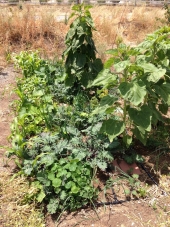Kelley Burnham wrote:This problem patch is closest to the drip line of the trees. I wonder, could there be exudates, tannins, or fungal strains that support redwoods but exclude other plant life? And, in just that small area?
Yes. Yes, indeedy. The drip line you indicated is possibly an area of high concentration for the "feeder roots" of the redwood- they love to stay in shallow soil where oxygen is abundant, to capture as much N as possible from aerobic bacteria, dew runoff, etc. Is there standing water in the problem area at any time during the year, or is it maybe naturally moist soil? If your dead zone is the closest to the trees, it stands to reason that it would be "invaded" by redwood roots, and affected accordingly, before anywhere else. Also, conifer trees are the only plants that can be colonized by endo-mycorrhizae, which actually grow
within root tissues, as opposed to ecto-mycorrhizae, which just colonizes the surface of roots. It is possible that the fungal dominance of the redwood mycorrhizae are outcompeting other microbes in the soil, keeping other plants from being able to thrive there? Here's the way my thought process is rolling here:
A. Redwoods and turfgrass co-exist for X number of years.
B. Turf gets pulled up, likely with a lot of topsoil still attached to it, and creates a new layer of oxygen-rich soil
C. Roots branch out, aggressively, and near where they touch the surface, their fungal cohabitants have a sort of root stronghold, from which to subjugate the bacterial natives of the now-dead-zone. Mwuhhuhahahahaha
Additionally, if you've been ammending the zone with fertilizers and compost, the redwoods may have now determined that this spot is sometimes rich in fertility, and have probably grown additional roots in this area in response. A way to test this theory is to dig into the spot and see if you come up with lots of smaller, woody, roots, covered in a good-smelling white web-like substance. If you find them here, then this could be your culprit, and the problem may end up being a systemic one- it could be that the redwood roots are branching out from their previous confines to invade the newly (relative to a redwood) worked ground that holds so much fertility.
Would you be able to post some pictures? I'm getting rambly, and without pictures, I'm basically just creating my own fantasy dead-zone in my head and giving it the properties that come along with such things, namely infinite possibility hehehe...





































 1
1




 1
1








 1
1








